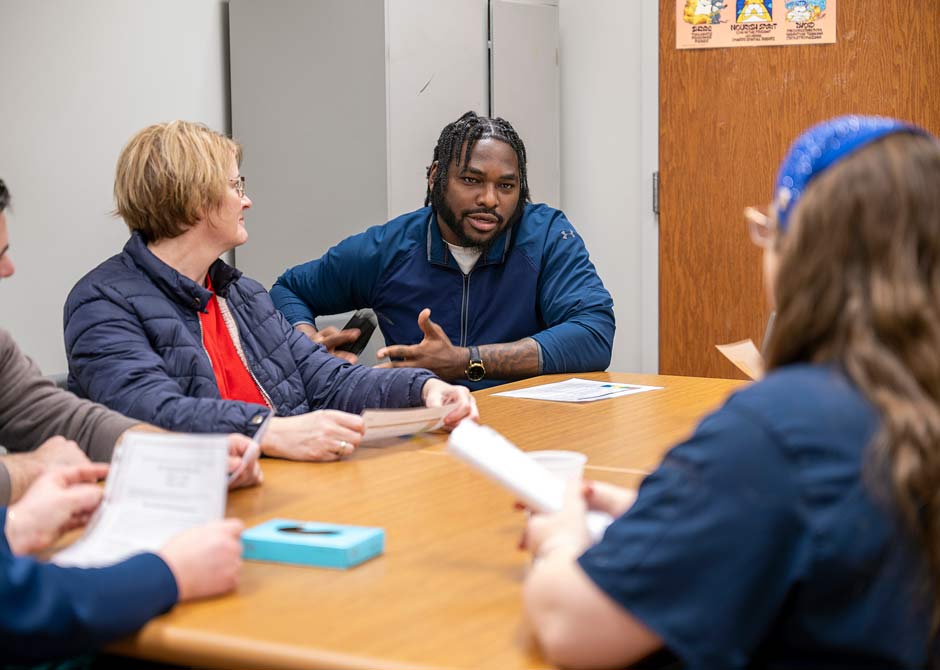 Mental and behavioral health conditions are complex, requiring personalized treatment plans and specially trained experts to treat. There’s no one-size-fits-all approach to improving symptoms and helping you feel better.
Mental and behavioral health conditions are complex, requiring personalized treatment plans and specially trained experts to treat. There’s no one-size-fits-all approach to improving symptoms and helping you feel better.
At The Ohio State University Wexner Medical Center in Columbus, Ohio, we have various levels of care and treatment options available, depending on what type of mental health condition you have and its severity. We not only offer effective inpatient care for those who need round-the-clock supervision, but we also provide different levels of outpatient care called partial hospitalization (PHP) and intensive outpatient (IOP) programs.
If you or a loved one are struggling with a mental health condition, the Ohio State Wexner Medical Center and its Harding Hospital can be a great choice for care given our ability to treat people no matter where they are in their recovery journey.
What are partial hospitalization and intensive outpatient programs?
Partial hospitalization and intensive outpatient programs are therapeutic treatment experiences for individuals who require more than the conventional outpatient level of care but do not need the security of 24-hour inpatient care. Basically, they allow someone to receive intense treatment and still reside at home.
Outpatient refers to the fact that these treatments don’t require an overnight hospital stay, and a person can usually continue working and maintaining a family while receiving care. Our standard outpatient programs involve weekly, or less frequent, visits with providers, whereas partial hospitalization and intensive outpatient programs require lengthier and more frequent visits during the week.
These programs can act as a bridge to help a person transition from an inpatient setting to an outpatient community setting for treatment. They can also assist a person who is struggling to cope with their symptoms with outpatient therapy alone. These programs are designed to treat a variety of psychiatric illnesses using group psychotherapy, psychopharmacology, psychoeducation and individual psychotherapy.
What’s the difference between partial hospitalization and an intensive outpatient program?
The difference between these two levels of care is the number of hours spent in treatment each week and the severity of your condition.
If you’re just leaving inpatient care at the hospital, you and your provider might opt for partial hospitalization to continue your path toward improving your mental health. In partial hospitalization, therapy and other treatments are usually given five days a week, five or six hours each day.
Intensive outpatient programs are a step down from partial hospitalization. Individuals at this level of care receive treatments two to three hours a day, two to three times a week. This is less than partial hospitalization but more intense than standard outpatient care.
What to expect in PHP and IOP
If you and your provider decide partial hospitalization or an intensive outpatient program is the right treatment path for you, you’ll attend various sessions and participate in a variety of therapies, depending on your needs and goals.
While in a PHP or an IOP you might:
- Participate in individual and group psychotherapies
- Attend educational sessions
- Meet with providers about medication management
- Work on relationships with family therapy
- Learn coping skills, such as mood regulation or conflict resolution
- Continually plan for care following discharge
The partial hospitalization and intensive outpatient staff at Ohio State Harding Hospital is made up of caring professionals dedicated to providing high-quality programming to improve the lives of those we serve.
During treatment, we’ll work with established outpatient providers to improve treatment outcomes and transition you between levels of care.
How long are most partial hospitalization and intensive outpatient programs?
This can vary for each program and individual, but usually these services last between four and eight weeks.
For partial hospitalization, people usually spend five or six hours a day, five days a week in treatment. For IOP, people usually spend two or three hours a day, two or three days a week in treatment.
Partial hospitalization and intensive outpatient program options available at Ohio State
Here’s a sampling of the programs we have available:
-
General Adult Partial Hospitalization and Intensive Outpatient Combination Program
-
General Adult Evening Intensive Outpatient Program
-
Young Adult Partial Hospitalization and Intensive Outpatient Combination Program
-
Young Adult Intensive Outpatient Program – Mood Disorder and Problematic Habits Intervention Track
-
Young Adult Intensive Outpatient Program – Mood Disorder Intervention Track
Why choose Ohio State for partial hospitalization and intensive outpatient treatment?
The Ohio State Wexner Medical Center is a leader in treating people with mental health conditions. One big reason for that is our partial hospitalization and intensive outpatient programs.
You should choose us for care because we have the following:
- Capacity – Many of our intensive outpatient mental health care providers are accepting new patients, and we’re constantly recruiting new specialists to keep up with demand.
- Evidence-based therapies – All of the partial hospitalization and intensive outpatient care we provide follow best practices based on years of research and evidence of what works the best and the quickest.
- Full continuum of services – While we have a full range of partial hospitalization and intensive outpatient programs, we also offer emergency services, inpatient care and outpatient services if your condition and symptoms require a different level of care.
- Care for treatment-resistant conditions – If psychotherapy and medications don’t work as well as we’d like, we have various other forms of therapy available. As part of our Depression Recovery Center and other specialty clinics, we offer interventional psychiatry methods, such as transcranial magnetic stimulation and ketamine therapy, that aren’t always available elsewhere.
- Latest innovations and research – As part of an academic medical center, our mental and behavioral health experts have a strong commitment to researching new and innovative ways to prevent, diagnose and treat mental health conditions.
